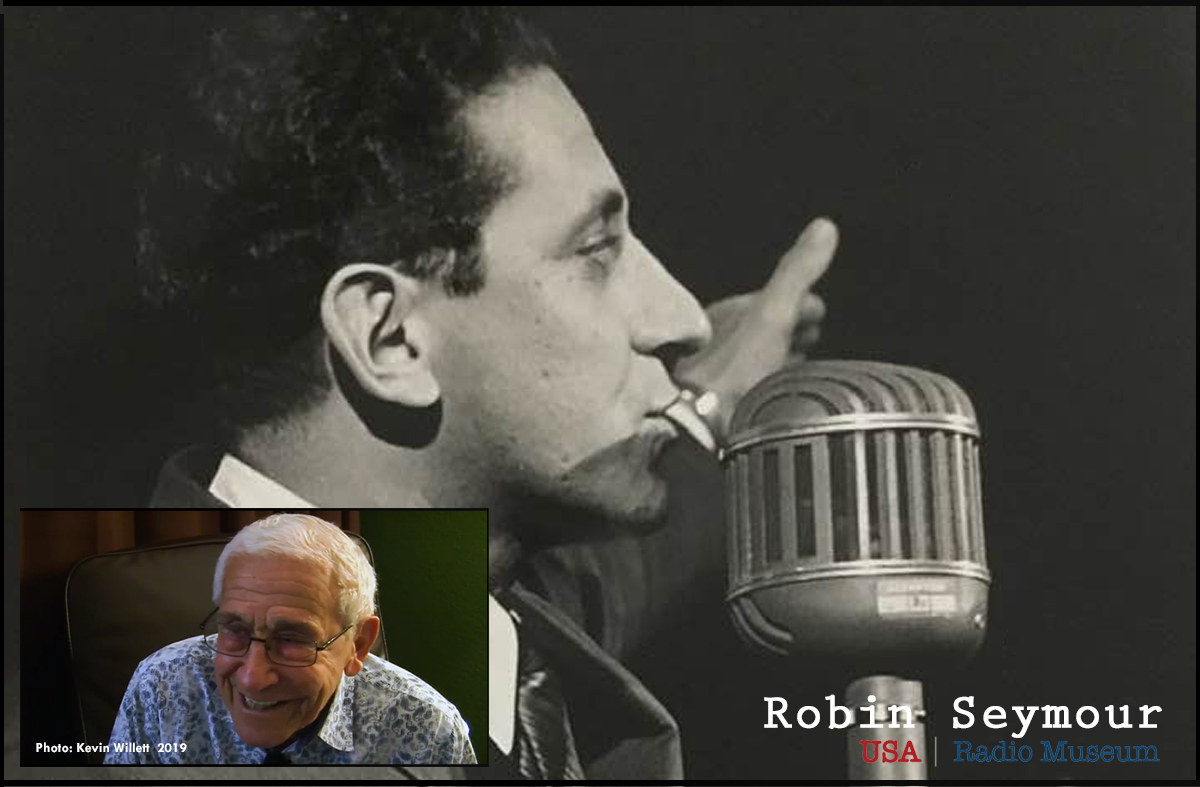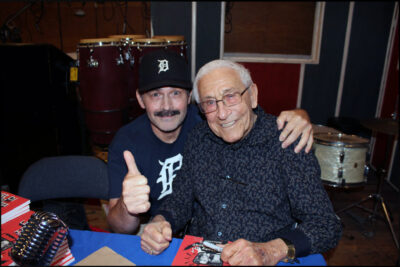Robin Seymour: The DJ Who Launched a Thousand Hits From Army Radio to Detroit’s Airwaves: The Making of a Legend Detroit in the mid-20th century
Robin Seymour: The DJ Who Launched a Thousand Hits
From Army Radio to Detroit’s Airwaves: The Making of a Legend
Detroit in the mid-20th century was a city bursting at the seams with musical energy—waiting for the right voice to usher in its golden era of rhythm & blues and rock & roll. That voice belonged to Robin Seymour.
In August 1951, the Detroit Free Press called Seymour one of the city’s “youngest and most experienced DJs.” At just 25 years old, he had already spent eight years on the air, making waves in a broadcasting career that began in grade school. He honed his skills through programs sponsored by the Board of Education before graduating from Central High School.
Determined to turn his passion into a profession, Seymour balanced two roles—student at Wayne State University and announcer at WJBK—before being called to serve in the U.S. Army. While stationed in Germany, he was transferred to Armed Forces Radio in Frankfurt, refining his ability to command an audience with energy and precision.
Once back stateside, Seymour finished his studies and briefly worked at NBC’s Baltimore affiliate before returning home to Detroit in 1947. It was on June 1, 1947, that he officially joined WKMH, the station where he would break barriers and define an era of radio history.
Robin Seymour was named “Disc Jockey of the Year” by Billboard magazine in 1953, a testament to his influence in shaping Detroit’s radio scene. He was also recognized by Hit Parader in 1954, further solidifying his status as one of the most respected DJs in the country. Seymour’s “Bobbin’ with Robin” show on WKMH was groundbreaking, as he was one of the first white DJs in Detroit to regularly play Black artists and groups, helping introduce rhythm & blues and early rock & roll to a wider audience.
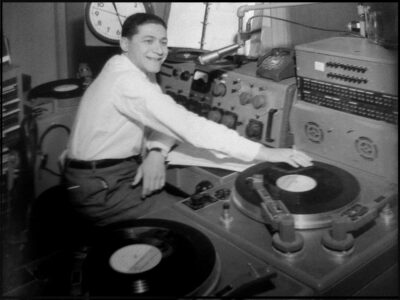 His decision to feature Black artists was particularly significant given the racial climate of the time. WKMH’s studios were located in Dearborn, a predominantly white suburb of Detroit, where Mayor Orville Hubbard was known for his racially biased policies. Despite this, Seymour championed Black musicians, giving airtime to artists who might have otherwise struggled to gain exposure in mainstream radio. His willingness to break racial barriers helped pave the way for the Motown sound, which would later dominate the airwaves.
His decision to feature Black artists was particularly significant given the racial climate of the time. WKMH’s studios were located in Dearborn, a predominantly white suburb of Detroit, where Mayor Orville Hubbard was known for his racially biased policies. Despite this, Seymour championed Black musicians, giving airtime to artists who might have otherwise struggled to gain exposure in mainstream radio. His willingness to break racial barriers helped pave the way for the Motown sound, which would later dominate the airwaves.
Seymour’s influence extended beyond radio—his record hops and live concerts, including Robin Seymour’s Original Rock ‘n’ Roll Revue at the Fox Theater, helped promote Black artists and integrate audiences. His legacy as a Detroit broadcasting pioneer remains strong, as he played a crucial role in shaping the city’s musical identity.
Robin Seymour was mentored early in his career by Ed McKenzie, the legendary WXYZ and WJBK DJ known as “Jack the Bellboy”, as well as Eddie Chase. McKenzie, in particular, played a pivotal role in Seymour’s development. According to Seymour, McKenzie once told him, “So you think you want to make radio a career? Don’t. You will always be on the outside looking in.” This challenge motivated Seymour to prove himself and carve out his own path in broadcasting.
Despite their initial rivalry—since they shared the same time slot on WKMH and WJBK—McKenzie and Seymour eventually became close friends. Seymour also played a key role in introducing Columbia Records to singer Johnnie Ray, helping launch Ray’s career after seeing him perform at Detroit’s Flame Showbar.
Robin Seymour’s Bobbin’ with Robin on WKMH was a groundbreaking radio show, helping to introduce rhythm & blues and rock & roll to Detroit audiences. His opening theme, “Bobbin’ With the Robbin” by The Four Lads, set the perfect tone for his energetic and engaging broadcasts. The song, backed by Percy Faith’s Orchestra, had a lively rhythm that matched Seymour’s charismatic on-air presence.
Robin Seymour | Reflections and Memories
Audio Digitally Remastered by USA Radio Museum
Robin Discovers Johnnie Ray
Robin Seymour played a pivotal role in Johnnie Ray’s rise to fame. Seymour discovered Ray while he was performing at Detroit’s Flame Showbar, an iconic nightclub known for showcasing rhythm & blues talent. Recognizing Ray’s unique style—his emotional delivery and dramatic stage presence—Seymour convinced Columbia Records’ Danny Kessler to make a test pressing of Ray’s music.
This led to Ray signing with Okeh Records, a subsidiary of Columbia, and releasing his breakthrough hit “Cry” in 1951. The song became a massive success, reaching #1 on Billboard’s Pop and R&B charts, selling over two million copies, and earning Ray the nickname “The Nabob of Sob” for his deeply expressive performances.
Seymour’s ability to spot talent was remarkable, and his support helped launch Ray’s career, making him one of the most influential figures in early rock & roll.
Elvis Who? Robin Gives Thumbs-Down
Robin Seymour had an interesting connection to Elvis Presley, though he wasn’t initially convinced of Elvis’s future success. According to Seymour’s daughter, Deborah Young, he had a keen ear for talent but famously misjudged Elvis, once saying, “This guy is gonna bomb.” Of course, history proved otherwise, as Elvis became one of the biggest stars in music.
Elvis made his first Detroit appearance at the Fox Theater on May 25, 1956, during a whirlwind tour following the success of “Heartbreak Hotel.” The concert was met with deafening screams from fans, and Elvis’s performance left a lasting impression on Detroit’s music scene. Seymour, as a major radio personality at the time, was deeply involved in promoting rock & roll, though he initially underestimated Elvis’s impact.
Despite his early skepticism, Seymour continued to champion rock & roll and Motown, helping shape Detroit’s musical landscape. His ability to recognize talent—except for that one famous misstep—cemented his legacy as a Detroit broadcasting pioneer.
What followed was an unparalleled legacy in Detroit broadcasting, spanning radio, television, and live music events that shaped the very foundation of Motown and rock & roll.
Robin’s Imprint in Detroit Broadcasting Lore
Robin Seymour was a trailblazer in radio and television, setting a high standard for DJs and broadcasters who followed. His influence can be seen in several key ways:
- Pioneering Rock & Roll on Detroit Radio – Seymour was among the first DJs in Detroit to embrace rock & roll and rhythm & blues, helping to break racial barriers in music by playing Black artists for a wider audience. His willingness to promote Motown acts like Stevie Wonder, The Supremes, and Marvin Gaye inspired other DJs to follow suit.
- Engaging Audience Interaction – He was one of the first DJs to ask listeners for their opinions on new records, making radio more interactive and audience-driven. This approach became a staple for future radio personalities.
- Dance-Party TV Format – His shows “Teen Town” and “Swingin’ Time” helped popularize the dance-party format, similar to American Bandstand, but with a strong Detroit identity. This format influenced later music television programs.
- Mentorship & Inspiration – Seymour’s success showed aspiring DJs that personality and connection with the audience were just as important as playing music. His smooth delivery and enthusiasm set a precedent for radio hosts who wanted to build a loyal following.
His impact on Detroit’s radio scene and beyond was profound, shaping how music was presented and celebrated.
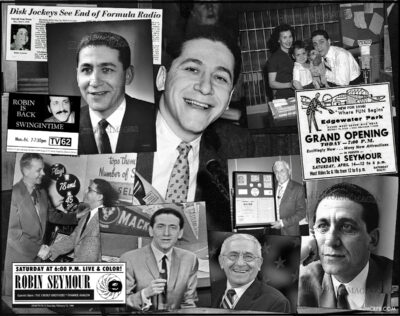
Second of two, Robin Seymour photo montage. The first one is on the back of Robin’s book. (Both created by the author; March 10, 2017)
Robin Seymour had a profound influence on the Detroit market, shaping the city’s radio in the 1950s and the television landscape in the 1960s. He was instrumental in introducing rock & roll and rhythm & blues to mainstream audiences, breaking racial barriers by playing Black artists on his radio show. His “Bobbin’ with Robin” program on WKMH was one of the first to engage listeners by asking for their opinions on new records, making radio more interactive. Seymour also hosted record hops and live concerts, including his Original Rock ‘n’ Roll Revue at the Fox Theater, which helped promote local and national talent.
One of the most significant moments in his career occurred on July 23, 1967, when Seymour was hosting a Motor Town Revue concert at the Detroit Fox Theater. That day marked the beginning of the Detroit civil disturbance, one of the most destructive riots in U.S. history. As news of the unrest spread, Seymour and the performers stepped outside and saw pillars of smoke rising over the city. The sight reminded Seymour of his experiences in Germany during World War II, making him feel sick to his stomach. Recognizing the danger, he made the difficult decision to cancel the concert, ensuring the safety of the artists and audience members.
This event underscored Seymour’s deep connection to Detroit and his awareness of the city’s social and political climate. His contributions to radio and television helped shape the Motown era, and his decision on that fateful day reflected his responsibility as a broadcaster and community figure. Robin Seymour’s legacy has been highlighted in various documentaries and retrospectives, including Detroit Remember When: Rockin’ Robin Seymour on PBS (2020) and other archival footage. If you may be interested in seeing more about his career, you might enjoy watching clips from his shows like Teen Town and Swingin’ Time or interviews discussing his influence on Detroit radio and television.
Here are some great sources where you can find archival footage of Swingin’ Time with Robin Seymour:
- Retro Video Archive – This site has a collection of footage from Swingin’ Time, featuring performances by The Supremes, The Temptations, The Marvelettes, and more. You can explore it here.
- YouTube Playlist – A curated playlist of Swingin’ Time clips, including performances by Bob Seger, Question Mark & The Mysterians, and Paul Revere & The Raiders. Check it out here.
Teen Town: The Beginning of Detroit’s TV Dance Shows
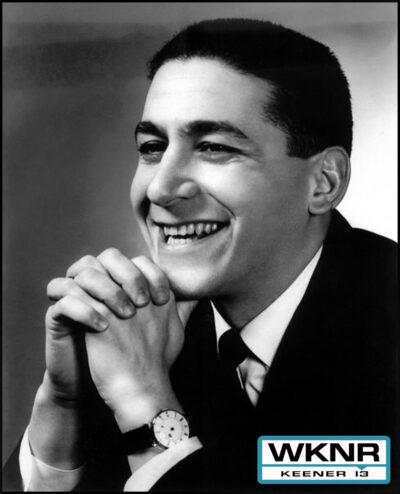 In 1963, Seymour co-created Teen Town, a dance-party format similar to American Bandstand. Each episode focused on a different Detroit-area high school, featuring students dancing to the latest hits while Seymour introduced local and national artists. The show quickly gained popularity and was picked up by CKLW-TV Channel 9 in Windsor, Ontario, expanding its reach beyond Detroit.
In 1963, Seymour co-created Teen Town, a dance-party format similar to American Bandstand. Each episode focused on a different Detroit-area high school, featuring students dancing to the latest hits while Seymour introduced local and national artists. The show quickly gained popularity and was picked up by CKLW-TV Channel 9 in Windsor, Ontario, expanding its reach beyond Detroit.
At the time, Seymour was still a radio DJ at WKNR (Keener 13), one of Detroit’s top Top 40 stations. However, his growing presence on CKLW-TV—a competitor—created tension with WKNR’s Vice-President and General Manager, Walter Patterson.
The WKNR Ultimatum and Seymour’s Decision
By 1964, Seymour was juggling both Teen Town on CKLW-TV and his radio duties at WKNR. They issued an ultimatum: either stay with WKNR or leave to focus on television.
Seymour, already a radio pioneer, made a bold decision—he left WKNR in April of 1965 and fully committed to CKLW-TV. This move allowed him to expand his television career, leading to the creation of Swingin’ Time, which became Detroit’s premier teen music show.
Swingin’ Time: The Show That Defined an Era
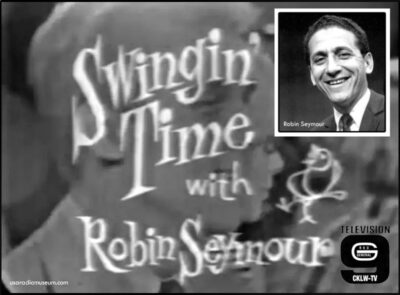 In 1965, Teen Town evolved into Swingin’ Time, a daily music and dance show that showcased Motown’s biggest stars. The show featured live performances, dance contests, and interviews, making it a must-watch for Detroit teens. Seymour’s charismatic hosting style and deep connections with Motown artists helped elevate the show’s status.
In 1965, Teen Town evolved into Swingin’ Time, a daily music and dance show that showcased Motown’s biggest stars. The show featured live performances, dance contests, and interviews, making it a must-watch for Detroit teens. Seymour’s charismatic hosting style and deep connections with Motown artists helped elevate the show’s status.
Swingin’ Time featured performances from The Supremes, The Temptations, Smokey Robinson & The Miracles, Marvin Gaye, Martha & The Vandellas, and Stevie Wonder. It became a launchpad for Detroit’s music scene, rivaling national programs like American Bandstand.
Seymour’s Dual Role at CKLW
After leaving WKNR, Seymour didn’t just host Swingin’ Time—he also became a disc jockey at CKLW radio, further solidifying his presence in Detroit broadcasting. His ability to connect with audiences across both radio and television made him one of the highest-paid DJs in America, earning over $100,000 per year—a staggering amount for the time.
Legacy of Teen Town & Swingin’ Time
Seymour’s decision to leave WKNR and embrace CKLW-TV allowed him to shape Detroit’s music scene in ways few others could. His shows introduced Motown legends to mainstream audiences, helped local artists gain exposure, and created a cultural phenomenon that defined Detroit’s golden era of music television.
The “Swingin’ Time Revue of ’67” at the Fox Theater
The Dramatics were on the marquee for the Swingin’ Time Revue of ’67 at the Fox Theater, alongside Martha & The Vandellas, J. J. Barnes, Deon Jackson, The Parliaments, Li’l’ Soul Brothers, and Choker Campbell and his Orchestra. That concert, which began on July 19, 1967, was tragically interrupted by the Detroit civil disturbance on July 23, 1967.
Robin Seymour, who was hosting the event, made the difficult decision to cancel the concert when he and the performers saw pillars of smoke rising over the city. The moment was so significant that it was restaged in the 2017 film Detroit, where The Dramatics were depicted on stage before being told to leave due to the unrest.
Here are some key moments from the Swingin’ Time Revue of ’67 at the Fox Theater, based on available sources:
- Concert Kickoff (July 19, 1967) – The revue began with a stellar lineup featuring Martha & The Vandellas, J. J. Barnes, Deon Jackson, The Parliaments, The Dramatics, Li’l’ Soul Brothers, and Choker Campbell and his Orchestra. The event was a celebration of Detroit’s vibrant R&B scene, showcasing some of the biggest names in Motown and soul music.
- Robin Seymour as MC – Seymour, the legendary Detroit DJ and TV host, was the master of ceremonies, bringing his signature energy to the event. His presence helped elevate the revue’s status as a must-see show for Detroit music fans.
- The Dramatics on Stage (July 23, 1967) – On the day the Detroit civil disturbance erupted, The Dramatics were performing on stage when they were abruptly told to leave due to the unfolding crisis. This moment was later restaged in the 2017 film Detroit, capturing the tension and uncertainty of that day.
- Concert Cancellation – As news of the unrest spread, Seymour and the performers stepped outside and saw pillars of smoke rising over the city. The sight reminded Seymour of his experiences in Germany during World War II, making him feel sick to his stomach. He made the difficult decision to cancel the concert, prioritizing the safety of the artists and audience.
- Impact on Detroit’s Music Scene – The cancellation of the revue was a significant moment in Detroit’s history, marking how the civil disturbance affected not just the city’s social and political landscape but also its thriving music scene. Many artists who performed at the revue went on to have successful careers, but the events of that day remain a poignant chapter in Detroit’s musical legacy.
Here are some sources that provide details on the Swingin’ Time Revue of ’67 at the Fox Theater:
- The Concert Database – This site lists the concert lineup, including Martha & The Vandellas, J. J. Barnes, Deon Jackson, The Parliaments, The Dramatics, Li’l’ Soul Brothers, and Choker Campbell and his Orchestra. It also notes that the concert was interrupted due to the Detroit civil disturbance. You can check it out here.
- 99WFMK Feature – This article provides historical context on Swingin’ Time and its impact on Michigan’s rock & roll scene. Read more here.
- Adam White’s Blog – This blog discusses Robin Seymour’s career, including his role as MC for the July 23, 1967 concert at the Fox Theater and his reaction to the unfolding events of that day. Find it here.
These moments paint a vivid picture of the revue’s significance and the dramatic turn of events on July 23, 1967.
Seymour Helped Elevate R&B Artists and Motown’s Legacy
Robin Seymour played a crucial role in public acceptance for R&B records played on his radio shows, and later, contributed to Motown’s rise, using his platform to introduce Detroit’s emerging Black artists to mainstream audiences. Here are some key ways he influenced Motown:
- Early Airplay for ’50s Artists – Seymour was one of the first DJs in Detroit to regularly play Black artists on the radio, helping to break racial barriers in music. His show “Bobbin’ with Robin” on WKMH gave early exposure to Bill Haley & the Comets, Chuck Berry, the Del-Vikings, Little Willie John, Sarah Vaughn, Big Mama Thornton, Johnny Ace, the Clovers, the Ames Brothers, and many more others.
- Live Performances & Promotion – Seymour frequently hosted record hops and concerts, including his Original Rock ‘n’ Roll Revue at the Fox Theater, where Motown artists performed live. He also arranged for Little Stevie Wonder to perform at Garden City High School, drawing a crowd of 1,400 students.
- Television Exposure – His TV shows “Teen Town” and “Swingin’ Time” on CKLW-TV became a launchpad for many Motown stars, featuring performances by The Temptations, Martha & The Vandellas, and The Miracles. Motown founder Berry Gordy recognized the show’s influence and often sent his artists to perform.
- Cultural Integration – Seymour’s willingness to play Black artists on a station based in Dearborn, a predominantly white suburb with a racially biased mayor, Orville Hubbard, was groundbreaking. His efforts helped integrate audiences early-on and bring Motown’s sound to a wider demographic by the mid-1960s.
His broadcasting contributions helped Motown artists gain national recognition, shaping Detroit’s music scene and influencing the broader industry.
Robin Seymour Embraces Scott Morgan and The Rationals
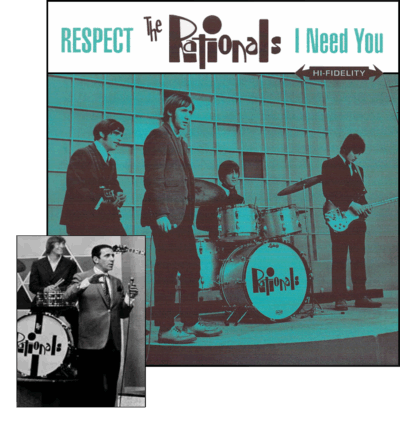 Robin Seymour had a deep appreciation for Scott Morgan and The Rationals, recognizing their talent and frequently featuring them on Swingin’ Time. The band, hailing from Ann Arbor, was a standout in the garage rock and blue-eyed soul scene, and their 1966 cover of Otis Redding’s “Respect” became a number one hit in Detroit before Aretha Franklin’s legendary version took the song to the top of the national charts in 1967.
Robin Seymour had a deep appreciation for Scott Morgan and The Rationals, recognizing their talent and frequently featuring them on Swingin’ Time. The band, hailing from Ann Arbor, was a standout in the garage rock and blue-eyed soul scene, and their 1966 cover of Otis Redding’s “Respect” became a number one hit in Detroit before Aretha Franklin’s legendary version took the song to the top of the national charts in 1967.
The Rationals made multiple appearances on Swingin’ Time, including a September 10, 1966 performance of “Respect”, which you can watch here. Their raw energy and soulful delivery made them a favorite among Detroit audiences, and Seymour’s support helped elevate their profile in the Midwest music scene.
Scott Morgan, the band’s frontman, was known for his powerful R&B-inflected vocals, and The Rationals shared stages with major acts like Jimi Hendrix, The Who, Cream, and Pink Floyd. Their influence extended beyond Detroit, and their music remains a cherished part of Michigan’s rock history.
The Next Chapter: WGPR and Beyond
By 1969, Seymour had moved Swingin’ Time to WGPR, which was America’s first Black-owned TV station. This transition was significant—WGPR provided a new home for Black artists, and Seymour continued to support and showcase rising talent. His presence helped cement WGPR’s legacy as a powerhouse in Detroit broadcasting history.
When Robin Seymour Cruised 1956 into 1970
Robin Seymour was the featured DJ on the Cruisin’ 1956 LP, part of the Cruisin’ series created by Ron Jacobs and released by Increase Records in June 1970. This album was designed to recreate the experience of listening to a 1956 radio broadcast, complete with station jingles, commercials, and Seymour’s original DJ commentary from his time at WKMH Detroit.
The Cruisin’ series was designed to recreate the experience of listening to a vintage radio broadcast from a specific year. Each album featured a legendary DJ, authentic station jingles, commercials, and hit songs from that era. Seymour was chosen to represent 1956, a pivotal year in rock & roll history.
Tracklist & Features
The album included classic rock & roll and doo-wop hits, interwoven with Robin Seymour’s original DJ commentary from his time at WKMH Detroit. Some standout tracks included:
- Chuck Berry – “Roll Over Beethoven”
- Frankie Lymon & The Teenagers – “Why Do Fools Fall in Love”
- Little Richard – “Tutti Frutti”
- The Platters – “The Great Pretender”
- The Five Satins – “In the Still of the Night”
- Bill Doggett – “Honky Tonk”
- The Cadets – “Stranded in the Jungle”
- The Crows – “Gee”
The album also featured authentic 1956 commercials, including ads for Faygo Root Beer, Ford, Budweiser, and Detroit Times, along with WKMH jingles and station IDs.
Robin Seymour’s Role
Seymour’s smooth, charismatic voice guided listeners through the album, making it feel like a real-time radio broadcast from 1956. His station announcements, sports headlines, and show promos added to the immersive experience, transporting listeners back to the golden age of rock & roll.
The Legacy of Cruisin’ 1956
The Cruisin’ series became a radio enthusiast favorite, offering listeners a time capsule experience of rock & roll’s early years. Seymour’s contribution to the 1956 edition was a nod to his Detroit radio roots, capturing the energy and excitement of the era when rock & roll was exploding onto the scene.
It’s incredible that this album is now 55 years old, yet it remains a treasured piece of radio history!
WKMH | Robin Seymour | 1956
Audio Digitally Remastered by USA Radio Museum
Robin Seymour’s Legacy Goes to Print
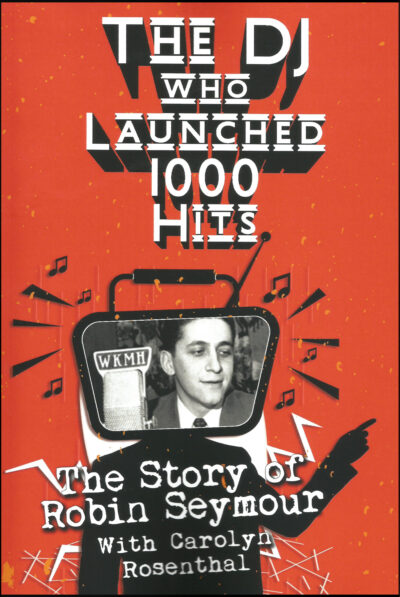 Robin Seymour’s memoir, The DJ That Launched 1,000 Hits, authored by Carolyn Rosenthal, was published in March 2019. The book chronicles Seymour’s incredible journey through Detroit radio and television, from his early days at WKMH to his groundbreaking work on Teen Town and Swingin’ Time. It highlights his role in promoting Motown artists, his influence on Detroit’s music scene, and his pioneering efforts in integrating Black artists into mainstream radio.
Robin Seymour’s memoir, The DJ That Launched 1,000 Hits, authored by Carolyn Rosenthal, was published in March 2019. The book chronicles Seymour’s incredible journey through Detroit radio and television, from his early days at WKMH to his groundbreaking work on Teen Town and Swingin’ Time. It highlights his role in promoting Motown artists, his influence on Detroit’s music scene, and his pioneering efforts in integrating Black artists into mainstream radio.
The memoir also includes rare photographs and personal stories, offering a deep dive into Seymour’s career and the golden era of Detroit broadcasting. Seymour was celebrated at book signings and reunion events in Detroit before his passing in 2020, where fans and fellow broadcasters honored his legacy.
Reflections by: Pat. St. John (Sirius XM); Art Voulo, Jr. (Radio’s Best Friend’); Scott Morgan (The Rationals); Pat Holiday (CKLW); Jim Harper (ex-Detroit radio morning personality); Lee Alan (Lee Alan Creative); Jerry Goodwin (former WKNR WKNR FM WABX personality); Tom Ryan (former CKLW WOMC personality); Dick Purtan (former WKNR CKLW WOMC Detroit radio morning personality).
The Last Great Detroit Radio Reunion (September 14, 2019)
Organized by Lee Alan, this event took place at the Suburban Collection Showplace in Novi, Michigan. It was a celebration of Detroit’s legendary radio personalities, bringing together icons from the city’s broadcasting history. For the first time, the reunion was open to the public, featuring live and video presentations, Q&A sessions, and book signings.
Robin Seymour was the guest of honor, recognized for his pioneering work in Detroit radio and television. His book, The DJ Who Launched 1,000 Hits, was available at the event, and fans had the opportunity to meet him and hear his stories firsthand. The reunion featured appearances from Pat St. John, Jim Kerr, Joey Reynolds, “Shotgun” Tom Kelly, and even included an appearance by early rock & roll pioneer, Jack Scott, also Scott Morgan of the Rationals, and many more.
Here are some great sources where you can find archival footage from The Last Great Detroit Radio Reunion:
- Metro Times Feature – This article provides an overview of the event, highlighting Robin Seymour’s role as the guest of honor and the legendary radio personalities who attended. Read more here.
- Facebook Photo Album – A collection of 97 photos from the reunion, capturing moments with Robin Seymour, Lee Alan, Bob Green, Johnny Williams, Charlie O’Brian, Paul Cannon, Jerry Goodwin, Pat St. John, Super Max Kinkel, The Reflections, and other honorable Detroit radio legends. Check it out here.
Robin Seymour’s Book Signing at the Motown Museum (September 12, 2019)
Just two days before the reunion, Seymour signed copies of his book at the Motown Museum, sharing memories of his time in Detroit radio and his connection to Motown artists. The event was filmed by Art Vuolo, known as “Radio’s Best Friend”, and the video is available on YouTube.
In the video, Seymour reminisces about his early days in radio, his experiences with Berry Gordy, and his role in promoting Motown artists on Swingin’ Time. He also discusses the beginnings of rhythm & blues on Detroit radio and his interactions with legendary musicians.
Here is a great sources where you can find footage from Robin Seymour’s book signing at the Motown Museum:
- YouTube Video by Art Vuolo – This 18-minute video features Robin Seymour at the Motown Museum, sharing memories of his early days in radio, his interactions with Berry Gordy, and his role in promoting Motown artists. Watch it here.
A Broadcasting Legacy Left Behind
Robin Seymour’s legacy is woven into the very fabric of Detroit broadcasting history. He was more than just a DJ—he was a visionary who bridged musical divides, championed artists before they became legends, and brought rock & roll and rhythm & blues into the mainstream at a time when few dared to do so. His influence stretched from the airwaves of WKMH and CKLW to the television screens of Swingin’ Time, launching the careers of Motown’s finest and forever changing how music was experienced in Detroit.
Robin Seymour | Hello Detroit!
Audio Digitally Remastered by USA Radio Museum
Robin Seymour passed away on April 17, 2020, leaving behind a legacy that shaped Detroit’s music and radio scene forever. He was 94.
Even after the final curtain call before hundreds of his fans and peers at the Last Detroit Radio Reunion in September 2019, his voice still resonates with every classic hit spun on Detroit’s old stations, in the memories of artists he uplifted, and in the hearts of music lovers who grew up with him as their guide. Robin Seymour didn’t just play records—he launched a thousand hits, and in doing so, he launched a thousand dreams.
Detroit is forever grateful.
_____________________
A USARM Viewing Tip: On your mobile or tablet device? Finger-tap all the above images inside the post and stretch image across your device’s screen for LARGEST digitized view.

